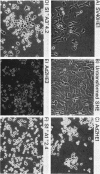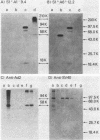Abstract
Syrian hamster embryo cells transformed by adenovirus type 2 (Ad2) or simian virus 40 (SV40) differ markedly in morphology, tumorigenicity, and susceptibility to in vitro lysis by nonspecific cytotoxic cells. Hybrid cells formed by fusing Ad2- and SV40-transformed Syrian hamster embryo cells may express only SV40 T antigens or both SV40 and Ad2 T antigens. Hybrids that express only SV40 T antigens are indistinguishable from the nonhybrid SV40-transformed phenotype, whereas hybrid cells that express T antigens from both viruses closely resemble the nonhybrid parental Ad2-transformed phenotype. Because these hybrid cells have been useful in the study of neoplastic transformation, we determined the amount of viral antigens that they accumulate in an attempt to correlate the level of expression of the transforming viral genes with some of their phenotypic properties. Hybrid cells that expressed proteins from both viruses showed reduced levels of SV40 T antigens compared with those of hybrid cells that did not express Ad2 T antigens. We also found that the production of several cellular proteins that influence cytomorphology was inhibited in hybrid and nonhybrid cells that expressed Ad2 T antigens, and the repression of these cellular proteins correlated with a change in cytomorphology from fibroblastic to spherical. Finally, we showed that the susceptibility of our hybrid cells to in vitro lysis by natural killer cells and activated macrophages, two putative host-effector cells involved in defense against neoplasia, correlated closely with the level of expression of a 58,000-dalton Ad2 protein. The results reported here, together with the results of previous studies, indicate that the oncogenic potential of hybrid cells that express both Ad2 and SV40 antigens is extremely sensitive to Ad2 expression, whereas other phenotypic properties depend on Ad2 expression in a dose-dependent manner.
Full text
PDF

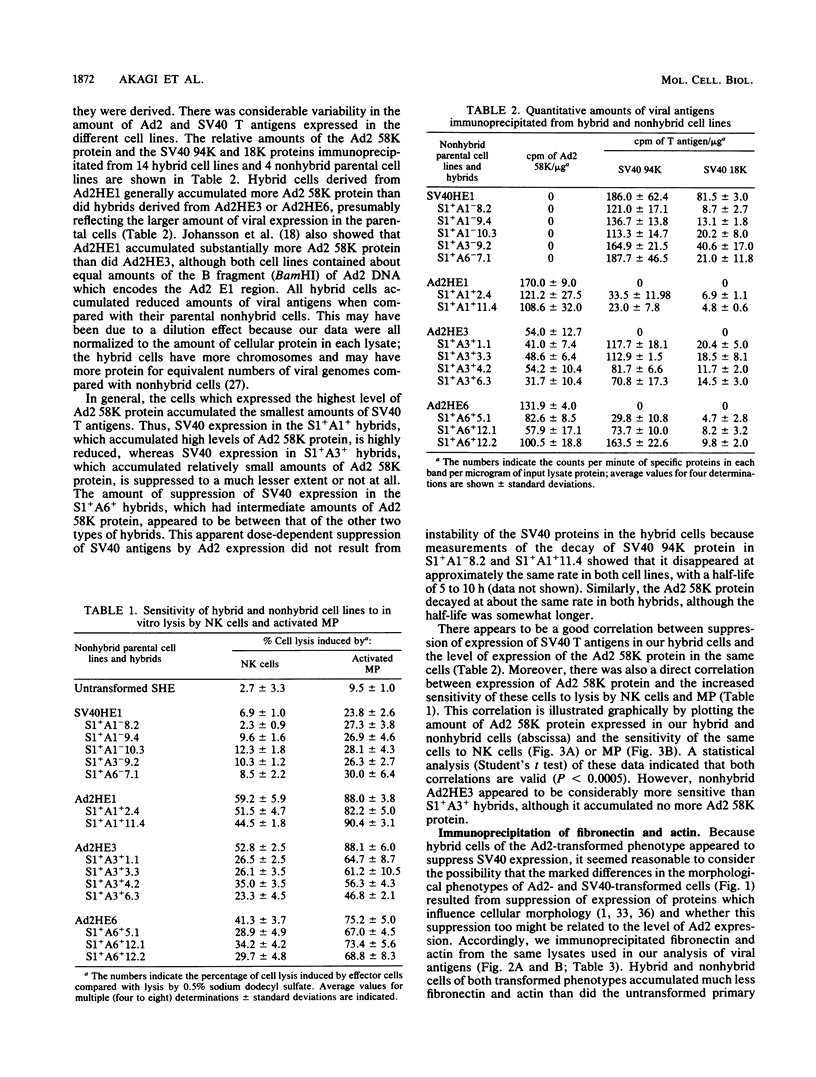
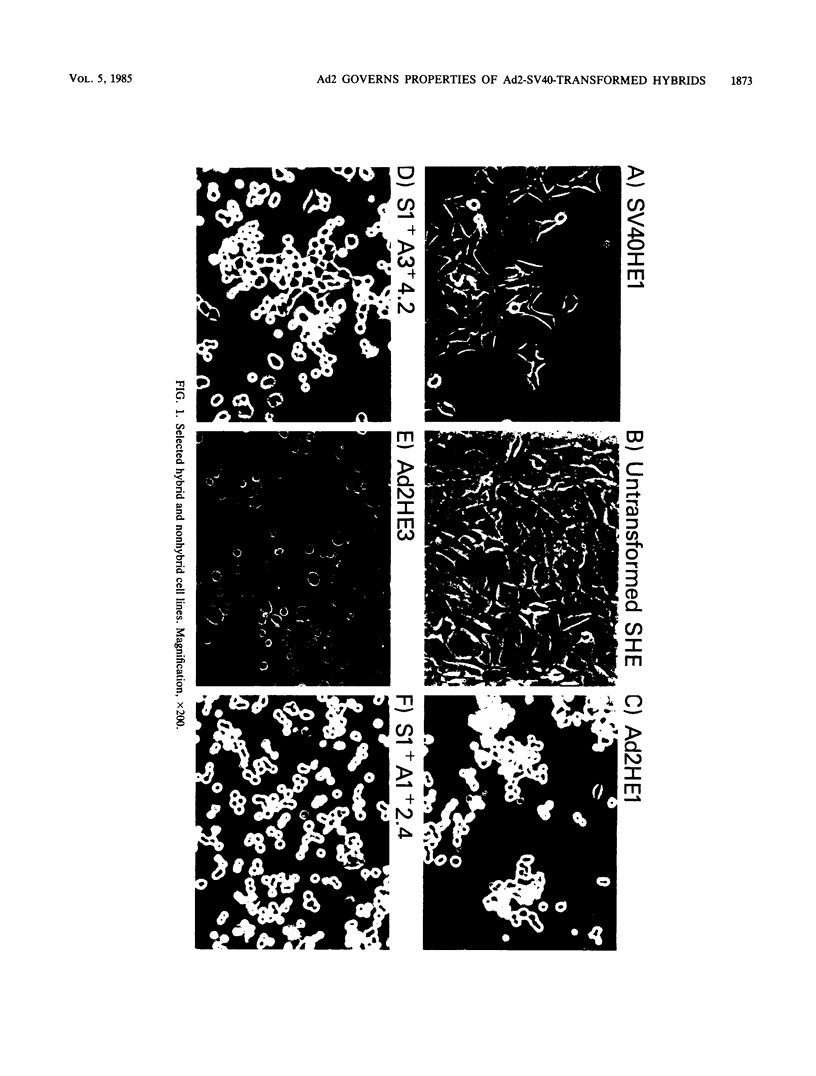
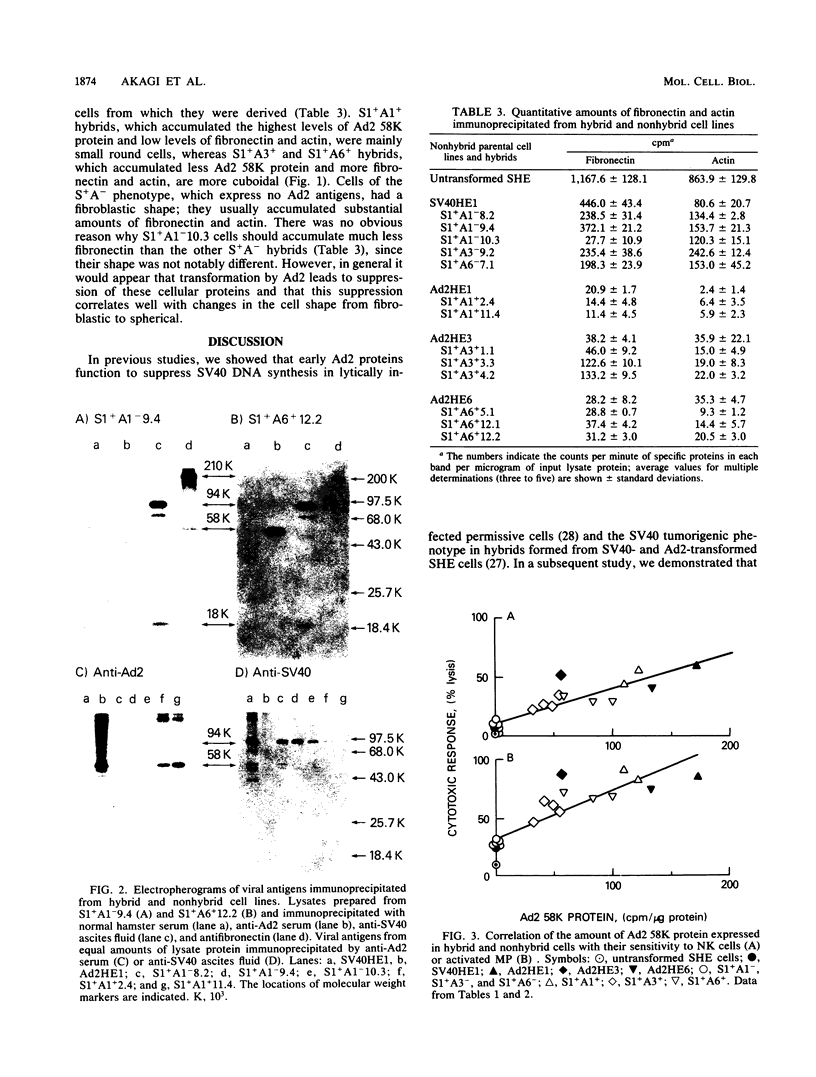

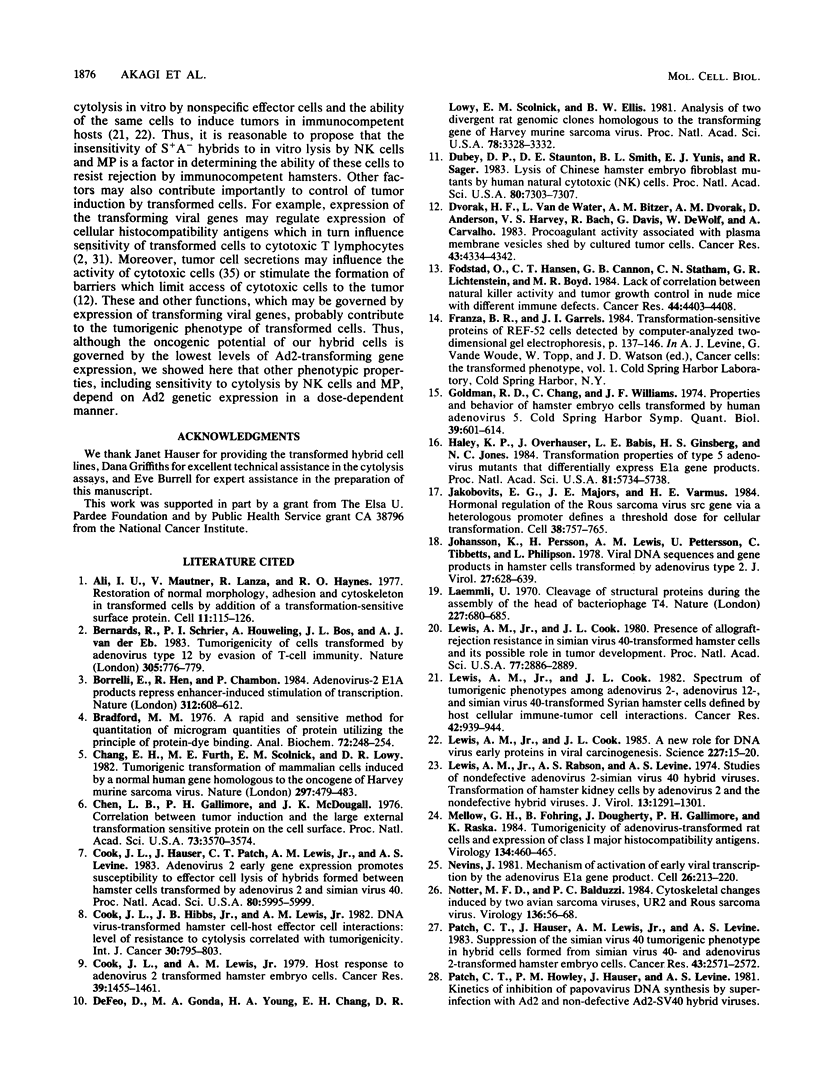
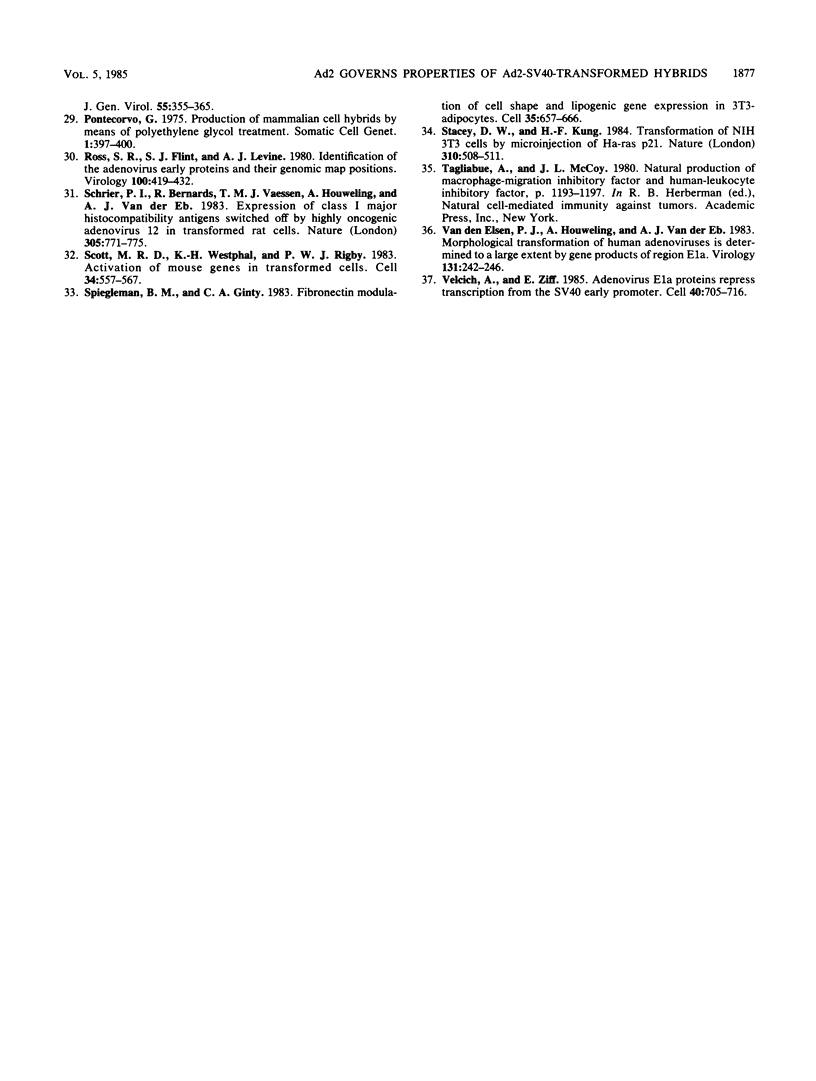
Images in this article
Selected References
These references are in PubMed. This may not be the complete list of references from this article.
- Ali I. U., Mautner V., Lanza R., Hynes R. O. Restoration of normal morphology, adhesion and cytoskeleton in transformed cells by addition of a transformation-sensitive surface protein. Cell. 1977 May;11(1):115–126. doi: 10.1016/0092-8674(77)90322-1. [DOI] [PubMed] [Google Scholar]
- Bernards R., Schrier P. I., Houweling A., Bos J. L., van der Eb A. J., Zijlstra M., Melief C. J. Tumorigenicity of cells transformed by adenovirus type 12 by evasion of T-cell immunity. 1983 Oct 27-Nov 2Nature. 305(5937):776–779. doi: 10.1038/305776a0. [DOI] [PubMed] [Google Scholar]
- Borrelli E., Hen R., Chambon P. Adenovirus-2 E1A products repress enhancer-induced stimulation of transcription. Nature. 1984 Dec 13;312(5995):608–612. doi: 10.1038/312608a0. [DOI] [PubMed] [Google Scholar]
- Bradford M. M. A rapid and sensitive method for the quantitation of microgram quantities of protein utilizing the principle of protein-dye binding. Anal Biochem. 1976 May 7;72:248–254. doi: 10.1016/0003-2697(76)90527-3. [DOI] [PubMed] [Google Scholar]
- Chang E. H., Furth M. E., Scolnick E. M., Lowy D. R. Tumorigenic transformation of mammalian cells induced by a normal human gene homologous to the oncogene of Harvey murine sarcoma virus. Nature. 1982 Jun 10;297(5866):479–483. doi: 10.1038/297479a0. [DOI] [PubMed] [Google Scholar]
- Chen L. B., Gallimore P. H., McDougall J. K. Correlation between tumor induction and the large external transformation sensitive protein on the cell surface. Proc Natl Acad Sci U S A. 1976 Oct;73(10):3570–3574. doi: 10.1073/pnas.73.10.3570. [DOI] [PMC free article] [PubMed] [Google Scholar]
- Cook J. L., Hauser J., Patch C. T., Lewis A. M., Jr, Levine A. S. Adenovirus 2 early gene expression promotes susceptibility to effector cell lysis of hybrids formed between hamster cells transformed by adenovirus 2 and simian virus 40. Proc Natl Acad Sci U S A. 1983 Oct;80(19):5995–5999. doi: 10.1073/pnas.80.19.5995. [DOI] [PMC free article] [PubMed] [Google Scholar]
- Cook J. L., Hibbs J. B., Jr, Lewis A. M., Jr DNA virus-transformed hamster cell--host effector cell interactions: level of resistance to cytolysis correlated with tumorigenicity. Int J Cancer. 1982 Dec 15;30(6):795–803. doi: 10.1002/ijc.2910300619. [DOI] [PubMed] [Google Scholar]
- Cook J. L., Lewis A. M., Jr Host response to adenovirus 2-transformed hamster embryo cells. Cancer Res. 1979 May;39(5):1455–1461. [PubMed] [Google Scholar]
- DeFeo D., Gonda M. A., Young H. A., Chang E. H., Lowy D. R., Scolnick E. M., Ellis R. W. Analysis of two divergent rat genomic clones homologous to the transforming gene of Harvey murine sarcoma virus. Proc Natl Acad Sci U S A. 1981 Jun;78(6):3328–3332. doi: 10.1073/pnas.78.6.3328. [DOI] [PMC free article] [PubMed] [Google Scholar]
- Dubey D. P., Staunton D. E., Smith B. L., Yunis E. J., Sager R. Lysis of Chinese hamster embryo fibroblast mutants by human natural cytotoxic (NK) cells. Proc Natl Acad Sci U S A. 1983 Dec;80(23):7303–7307. doi: 10.1073/pnas.80.23.7303. [DOI] [PMC free article] [PubMed] [Google Scholar]
- Fodstad O., Hansen C. T., Cannon G. B., Statham C. N., Lichtenstein G. R., Boyd M. R. Lack of correlation between natural killer activity and tumor growth control in nude mice with different immune defects. Cancer Res. 1984 Oct;44(10):4403–4408. [PubMed] [Google Scholar]
- Goldman R. D., Chang C., Williams J. F. Properties and behavior of hamster embryo cells transformed by human adenovirus type 5. Cold Spring Harb Symp Quant Biol. 1975;39(Pt 1):601–614. doi: 10.1101/sqb.1974.039.01.074. [DOI] [PubMed] [Google Scholar]
- Haley K. P., Overhauser J., Babiss L. E., Ginsberg H. S., Jones N. C. Transformation properties of type 5 adenovirus mutants that differentially express the E1A gene products. Proc Natl Acad Sci U S A. 1984 Sep;81(18):5734–5738. doi: 10.1073/pnas.81.18.5734. [DOI] [PMC free article] [PubMed] [Google Scholar]
- Jakobovits E. B., Majors J. E., Varmus H. E. Hormonal regulation of the Rous sarcoma virus src gene via a heterologous promoter defines a threshold dose for cellular transformation. Cell. 1984 Oct;38(3):757–765. doi: 10.1016/0092-8674(84)90271-x. [DOI] [PubMed] [Google Scholar]
- Johansson K., Persson H., Lewis A. M., Pettersson U., Tibbetts C., Philipson L. Viral DNA sequences and gene products in hamster cells transformed by adenovirus type 2. J Virol. 1978 Sep;27(3):628–639. doi: 10.1128/jvi.27.3.628-639.1978. [DOI] [PMC free article] [PubMed] [Google Scholar]
- Laemmli U. K. Cleavage of structural proteins during the assembly of the head of bacteriophage T4. Nature. 1970 Aug 15;227(5259):680–685. doi: 10.1038/227680a0. [DOI] [PubMed] [Google Scholar]
- Lewis A. M., Jr, Cook J. L. A new role for DNA virus early proteins in viral carcinogenesis. Science. 1985 Jan 4;227(4682):15–20. doi: 10.1126/science.3843807. [DOI] [PubMed] [Google Scholar]
- Lewis A. M., Jr, Cook J. L. Presence of allograft-rejection resistance in simian virus 40-transformed hamster cells and its possible role in tumor development. Proc Natl Acad Sci U S A. 1980 May;77(5):2886–2889. doi: 10.1073/pnas.77.5.2886. [DOI] [PMC free article] [PubMed] [Google Scholar]
- Lewis A. M., Jr, Cook J. L. Spectrum of tumorigenic phenotypes among adenovirus 2-, adenovirus 12-, and simian virus 40-transformed Syrian hamster cells defined by host cellular immune-tumor cell interactions. Cancer Res. 1982 Mar;42(3):939–944. [PubMed] [Google Scholar]
- Lewis A. M., Jr, Rabson A. S., Levine A. S. Studies of nondefective adenovirus 2-simian virus 40 hybrid viruses. Transformation of hamster kidney cells by adenovirus 2 and the nondefective hybrid viruses. J Virol. 1974 Jun;13(6):1291–1301. doi: 10.1128/jvi.13.6.1291-1301.1974. [DOI] [PMC free article] [PubMed] [Google Scholar]
- Mellow G. H., Föhring B., Dougherty J., Gallimore P. H., Raska K., Jr Tumorigenicity of adenovirus-transformed rat cells and expression of class I major histocompatibility antigen. Virology. 1984 Apr 30;134(2):460–465. doi: 10.1016/0042-6822(84)90313-1. [DOI] [PubMed] [Google Scholar]
- Nevins J. R. Mechanism of activation of early viral transcription by the adenovirus E1A gene product. Cell. 1981 Oct;26(2 Pt 2):213–220. doi: 10.1016/0092-8674(81)90304-4. [DOI] [PubMed] [Google Scholar]
- Notter M. F., Balduzzi P. C. Cytoskeletal changes induced by two avian sarcoma viruses: UR2 and Rous sarcoma virus. Virology. 1984 Jul 15;136(1):56–68. doi: 10.1016/0042-6822(84)90247-2. [DOI] [PubMed] [Google Scholar]
- Patch C. T., Hauser J., Lewis A. M., Jr, Levine A. S. Suppression of the simian virus 40 tumorigenic phenotype in hybrid cells formed from simian virus 40- and adenovirus 2-transformed hamster embryo cells. Cancer Res. 1983 Jun;43(6):2571–2575. [PubMed] [Google Scholar]
- Pontecorvo G. Production of mammalian somatic cell hybrids by means of polyethylene glycol treatment. Somatic Cell Genet. 1975 Oct;1(4):397–400. doi: 10.1007/BF01538671. [DOI] [PubMed] [Google Scholar]
- Ross S. R., Flint S. J., Levine A. J. Identification of the adenovirus early proteins and their genomic map positions. Virology. 1980 Jan 30;100(2):419–432. doi: 10.1016/0042-6822(80)90533-4. [DOI] [PubMed] [Google Scholar]
- Schrier P. I., Bernards R., Vaessen R. T., Houweling A., van der Eb A. J. Expression of class I major histocompatibility antigens switched off by highly oncogenic adenovirus 12 in transformed rat cells. 1983 Oct 27-Nov 2Nature. 305(5937):771–775. doi: 10.1038/305771a0. [DOI] [PubMed] [Google Scholar]
- Scott M. R., Westphal K. H., Rigby P. W. Activation of mouse genes in transformed cells. Cell. 1983 Sep;34(2):557–567. doi: 10.1016/0092-8674(83)90388-4. [DOI] [PubMed] [Google Scholar]
- Spiegelman B. M., Ginty C. A. Fibronectin modulation of cell shape and lipogenic gene expression in 3T3-adipocytes. Cell. 1983 Dec;35(3 Pt 2):657–666. doi: 10.1016/0092-8674(83)90098-3. [DOI] [PubMed] [Google Scholar]
- Stacey D. W., Kung H. F. Transformation of NIH 3T3 cells by microinjection of Ha-ras p21 protein. Nature. 1984 Aug 9;310(5977):508–511. doi: 10.1038/310508a0. [DOI] [PubMed] [Google Scholar]
- Velcich A., Ziff E. Adenovirus E1a proteins repress transcription from the SV40 early promoter. Cell. 1985 Mar;40(3):705–716. doi: 10.1016/0092-8674(85)90219-3. [DOI] [PubMed] [Google Scholar]
- van den Elsen P. J., Houweling A., van der Eb A. J. Morphological transformation of human adenoviruses is determined to a large extent by gene products of region E1a. Virology. 1983 Nov;131(1):242–246. doi: 10.1016/0042-6822(83)90549-4. [DOI] [PubMed] [Google Scholar]



